Does your cat leave a trail of fur wherever they go? Do you find yourself battling tangles and mats? Regular brushing is the solution! It’s not only important for your cat’s coat health but also surprisingly easy to master. Here’s why brushing matters:
- Less Shedding: Get rid of loose fur or dead hair before it ends up on your clothes and furniture.
- No More Mats: Keep your cat’s fur tangle-free, especially if they have a long, luxurious coat.
- Healthy Shine: Brushing helps distribute natural oils, leaving their coat soft and glossy.
- Prevent Fleas and Ticks: Regular grooming can help identify any fleas or “flea dirt” on your pet.
Ready to learn the right techniques? Let’s turn you into a brushing pro!
- Brushing reduces shedding, prevents mats, and keeps your cat’s coat shiny.
- Daily brushing is vital for long-haired cats to avoid matting.
- Consistency in grooming routine is important for cat’s coat health.
The information provided herein is for informational purposes only. Please refer to our disclaimer for more details..
- Understanding Your Cat’s Grooming Needs
- Preparing for a Positive Grooming Experience
- Desensitization Techniques for Anxious Cats
- Techniques to Brush Your Cat
- Managing Mats and Tangles
- Establishing a Routine to Groom Your Cat
- Beyond Brushing – A Well-Rounded Cat Grooming Routine
- Conclusion: How to Comb or Brush A Cat
Understanding Your Cat’s Grooming Needs
A cat’s individual grooming requirements depend on several factors. Consider the following to provide optimal care:
Breed and Coat Type
Short-haired: (e.g., Siamese, Abyssinian) These breeds require less frequent brushing, but regular grooming promotes healthy skin and coat and minimizes shedding.
Long-haired: (e.g., Maine Coon, Persian) Daily brushing is essential to prevent matting and maintain a luxurious coat.
Mat-prone: (e.g., Rex breeds, cats with very thick fur) Specialized tools and focused attention on potential problem areas may be necessary.
Lifestyle
Indoor cats: Year-round shedding is typically less, but brushing is still important for removing loose fur and maintaining coat health.
Outdoor cats: Exposure to the elements necessitates more frequent brushing for debris and tangle removal.
Essential Grooming Supplies
Here’s a breakdown of the primary brushing tools and their applications:
- Slicker brush: Multi-purpose tool suitable for most cats. Effectively removes loose hair and assists with detangling.
- Metal comb: Ideal for cats with long, dense fur. It reaches the undercoat, preventing and removing matted hair or knots.
- Bristle brush: Provides a gentle finishing touch, especially beneficial for short-haired cat breeds.
- Dematting comb: Designed specifically for addressing stubborn matting.
- Grooming gloves/mitts: May be preferable for cats sensitive to traditional brushes.
Additional Helpful Tools
- Detangling spray: Aids in smoothing fur and easing the removal of mats.
- Mat-splitter: Use with extreme caution for severe mats. Professional assistance may be safer.
- Pet-safe nail clippers: For regular nail maintenance if your kitty tolerates it.
Selecting appropriate grooming tools simplifies the process and enhances your cat’s comfort.
Preparing for a Positive Grooming Experience
Grooming should be enjoyable for your cat (and you!). Here’s how to set the stage for success:
- Timing is Everything: Choose a time when your cat is naturally relaxed, perhaps after a meal or a satisfying play session with toys. Make sure your cat is comfortable. Avoid grooming if your cat seems stressed or anxious.
- Peaceful Environment: Find a quiet spot in your home with minimal distractions. A closed room or a cozy corner can help your cat feel safe and secure.
- Make it Rain Treats (and Praise!): Have some of your cat’s favorite treats handy. Offer a treat before you start, during the brushing session, and a big reward at the end. Pair those treats with gentle petting and soothing words.
- Desensitization is Key: If your cat is new to grooming or seems hesitant, start by simply letting them see and smell the grooming tools. Place a brush or comb near their food bowl or favorite sleeping spot.
- Start Slowly: Especially for kittens or cats new to grooming, begin with short sessions of just a few minutes. Focus on areas your cat enjoys being touched, like under the chin or along their back.
Help your cat associate grooming with positive things like treats, affection, and relaxation. With patience, it can become a bonding experience you both look forward to!
Desensitization Techniques for Anxious Cats
Here are some specific desensitization tips for anxious cats:
The Power of Passive Presence
Place grooming tools in your cat’s favorite spots. Leave a brush or comb near their bed or on a window perch they enjoy. This lets them investigate the tools without pressure.
Feed your cat near the tools. Place their food bowl slightly closer to the grooming tools each day. This creates a positive association between the tools and something they love—food!
Touch and Treat
Soft touch first. When petting your cat, gently run the back of the brush or comb along areas they like to be stroked.
Reward the sniff. If they sniff or investigate the tool, immediately offer a treat and praise.
Never force contact. If the cat pulls away, let them. Forcing the issue can create a negative association.
Baby Steps in Brushing
One stroke at a time. Start with a single, gentle stroke with the brush, followed by a treat. Gradually increase the number of strokes over several sessions.
Focus on favorite spots. Stick to areas your cat truly enjoys being petted, like the sides of their face or along the base of their tail.
Extra Tips
- Pheromones for calm: Consider using Feliway spray or diffusers in your grooming area to create a sense of calm.
- Talk softly: Use a gentle, reassuring voice throughout the desensitization process.
- Go at their pace: Some cats take longer than others to acclimate. Be patient and consistent. If they show signs of stress, stop and try again later.
Remember, the goal is to create a positive emotional connection to the grooming tools and the experience itself. With time and patience, even the most anxious cat can learn to enjoy a good brushing session!
Techniques to Brush Your Cat
Here’s your simple guide on how to gently brush your cat like a pro…
Step-by-Step Brushing
- The Back and Sides: Start along your cat’s back, brushing in the direction their fur naturally grows. Use smooth, gentle strokes from their neck down towards their tail. Continue down their sides.
- Tummy Time (If Allowed): Some cats love a belly rub, others…not so much. If your cat tolerates it, brush their tummy with extra-gentle, short strokes. If they seem tense, skip this area.
- Legs and Tail: Use a lighter touch and shorter strokes on their legs and tail. Brush in the direction of fur growth.
- Face Time: Be very careful around the face! Use a soft brush and brush away from their eyes and nose. Many cats dislike having their faces brushed, so keep this part brief.
Sensitive Spots = Gentle Touch
Remember, tummies, legs, tails, and faces can be sensitive for cats. Pay attention to your cat’s signals and stop if they seem uncomfortable.
Managing Mats and Tangles
Mats and tangles can lead to skin irritation and discomfort. Here’s how to address these issues while minimizing stress for your feline companion:
Detangling Protocol
- Saturate the matted area with a detangling spray formulated specifically for feline coats.
- Utilize a wide-toothed metal comb, beginning at the peripheral aspect of the mat and gently progressing inward.
- Exert minimal tension to prevent breakage of the hair and reduce cutaneous irritation.
Detangling requires focused attention and a delicate approach. Desist if your cat exhibits signs of agitation and resume at a later time.
Indications for Professional Intervention
- Severe matting, particularly in close proximity to the skin increases the risk of inadvertent lacerations and discomfort during removal.
- Cats demonstrating pain responses or aversion to detangling attempts may benefit from sedation administered by a veterinarian in conjunction with professional grooming.
Adherence to a regular brushing regimen remains the most effective strategy for minimizing the formation of mats and tangles.
Establishing a Routine to Groom Your Cat
The key to keeping your cat’s coat healthy and beautiful is consistency! Here’s a general guide, but remember to adjust based on your cat’s individual needs:
Brushing Frequency by Coat Type
- Short-haired Cats: Aim for 1-2 brushing sessions per week. This helps remove loose fur, stimulate skin oils, and prevent matting.
- Long-haired Cats: Daily or every-other-day brushing is ideal to prevent tangles and mats from forming.
Shedding Season Adjustments: All cats shed more during certain times of the year. Increase brushing frequency during these shedding periods to help manage loose fur.
Additional Considerations
- Outdoor Cats: Cats who spend time outdoors might need more frequent brushing to remove dirt, leaves, and debris from their fur.
- Older Cats: Senior cats may struggle to groom themselves as effectively, so they may benefit from more frequent brushing assistance.
Remember, a regular grooming routine makes for a happier and healthier cat!
Beyond Brushing – A Well-Rounded Cat Grooming Routine
Excellent grooming goes beyond just brushing. Here are other key areas to address for your cat’s overall well-being:
- Nail Trimming: Overgrown nails can be uncomfortable and even lead to injuries. If you’re comfortable trimming your cat’s nails, use specialized cat nail clippers and proceed with caution. Many owners prefer having a veterinarian or groomer handle this task.
- Ear Cleaning: Healthy cat ears should be clean and odor-free. If you notice wax build-up or debris, consult your veterinary doctor. They can provide safe ear cleaning solutions and demonstrate the proper technique.
- Dental Care: Just like us, cats need good dental hygiene! Brushing your cat’s teeth with a cat-specific toothpaste is ideal. If that’s a challenge, schedule regular dental cleanings with your veterinarian.
- Diet for a Shiny Coat: A healthy diet rich in essential nutrients and omega fatty acids supports healthy skin and a lustrous coat from the inside out. Talk to your vet about the best food choices for your cat.
If you are ever unsure about any aspect of grooming, consult your veterinarian or a professional groomer for advice and assistance. They want to help both you and your cat stay happy and healthy!
Conclusion: How to Comb or Brush A Cat
Regular grooming benefits your cat’s health and strengthens your bond. It helps maintain their skin and coat, reduces shedding and hairballs, and gives you a chance to spot potential health issues early on. Most importantly, grooming can become a time of positive interaction, building trust between you and your feline companion.
Find a routine that works for both of you to make grooming an enjoyable and rewarding experience for all.
1Kviews
Share on Facebook
 Dark Mode
Dark Mode 

 No fees, cancel anytime
No fees, cancel anytime 






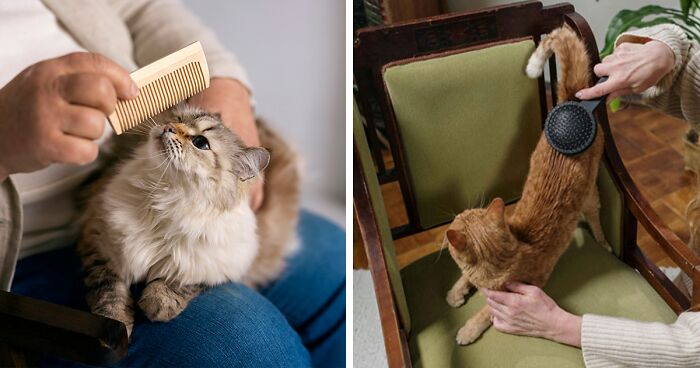
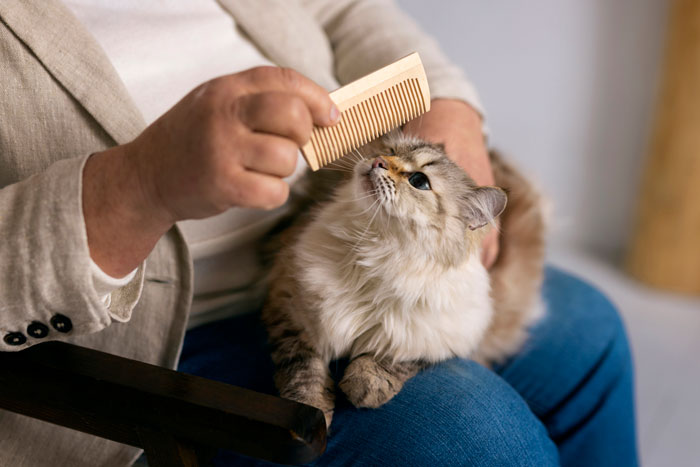 Image credits:
Image credits: 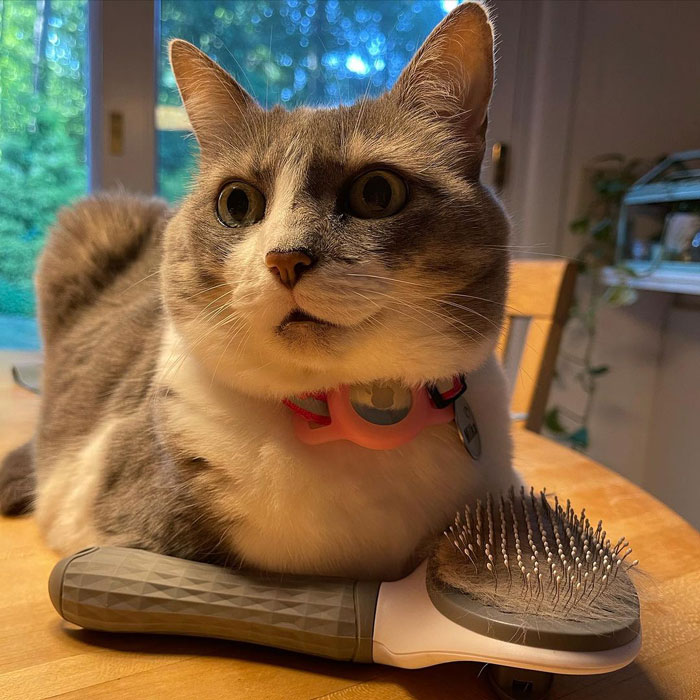 Image credits:
Image credits: 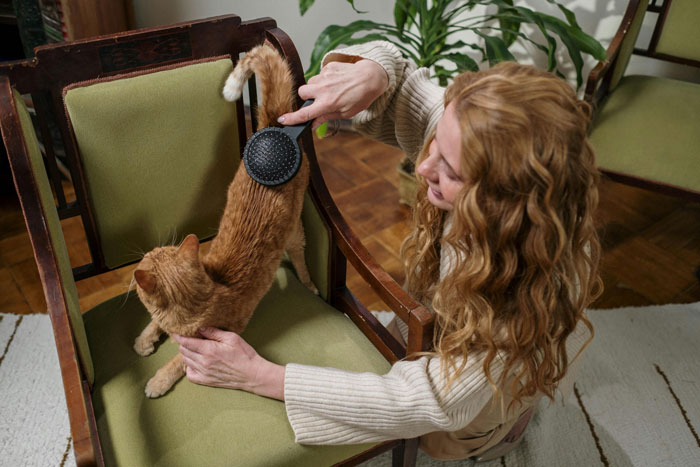 Image credits:
Image credits: 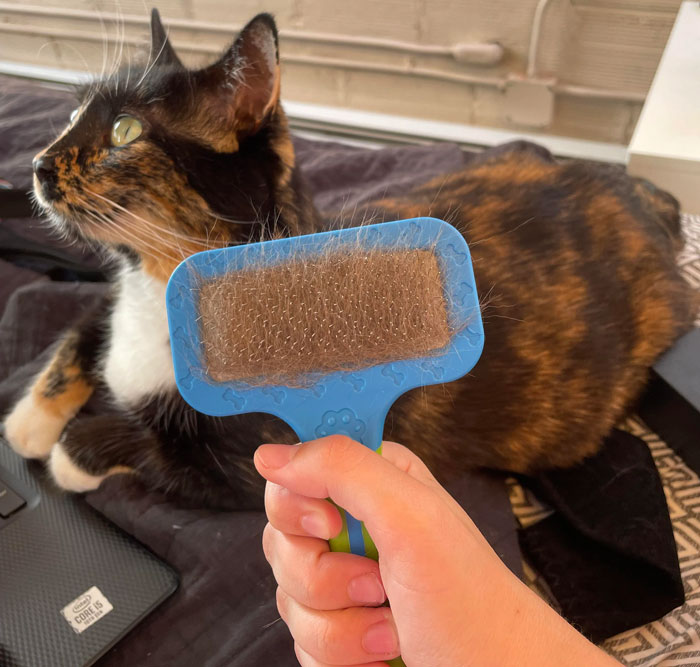 Image credits:
Image credits: 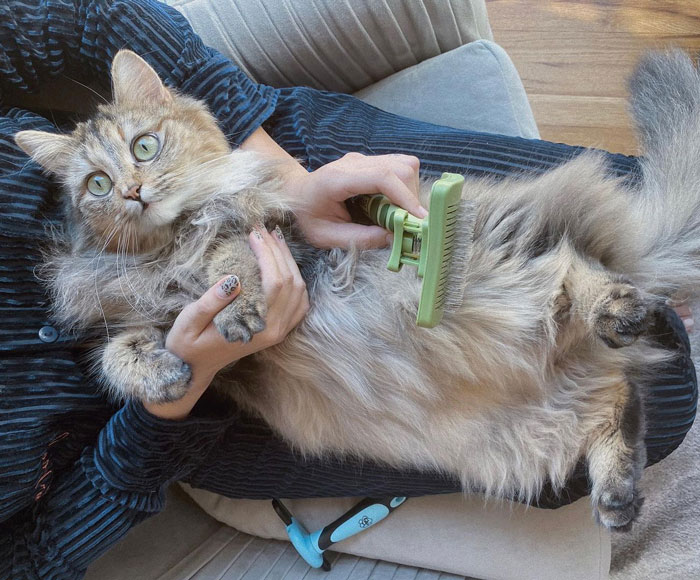 Image credits:
Image credits: 










































0
0